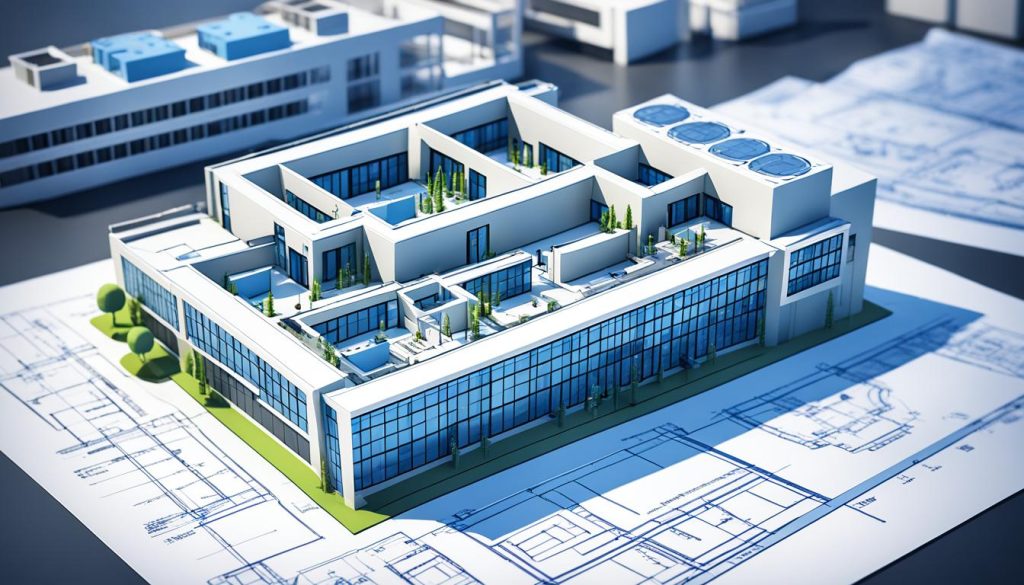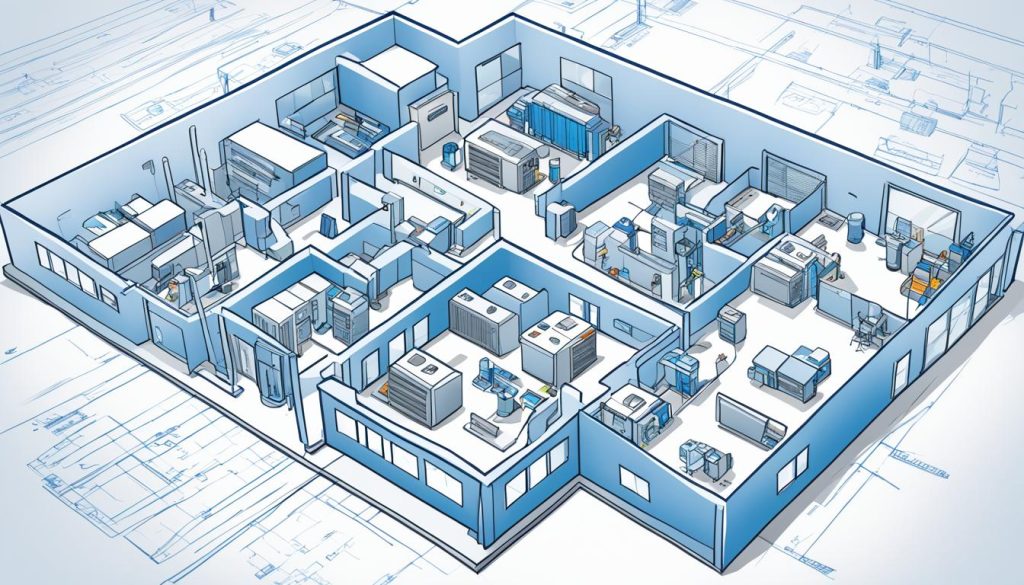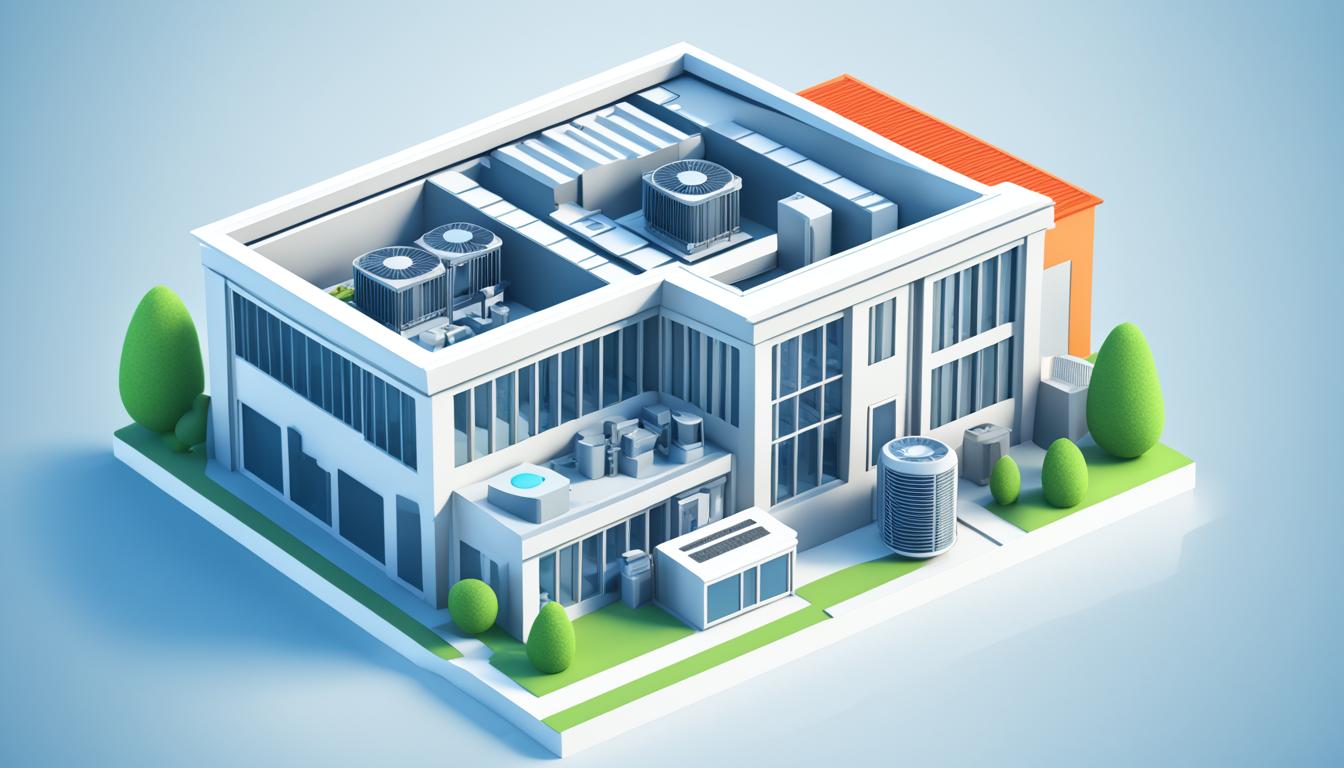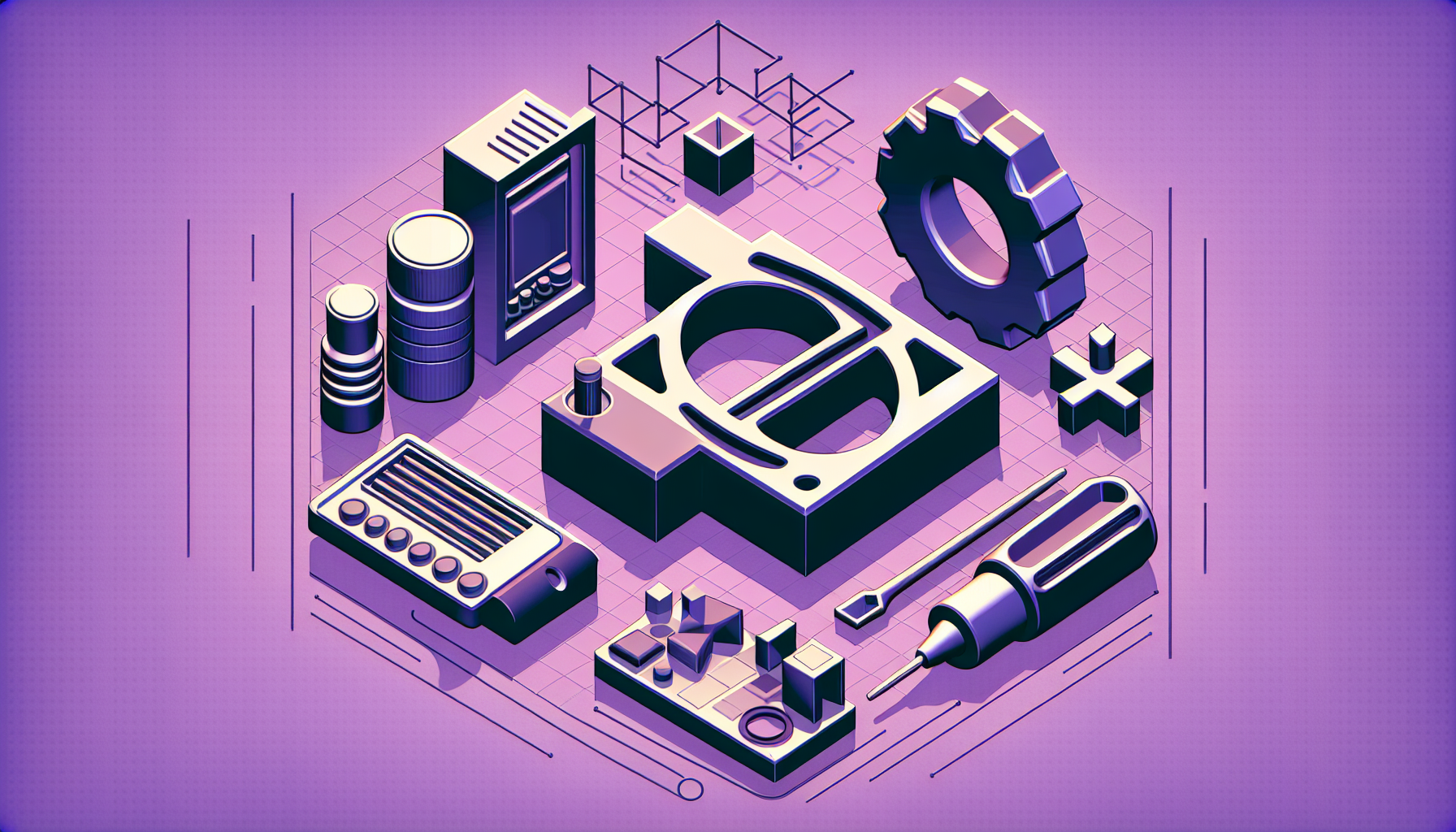You can link HVAC design software with CAD systems by using compatible tools and a clear process. This makes your work flow better, boosts project efficiency, and helps teams work together better in building design.
Linking HVAC software with CAD systems is key for automating mechanical engineering. It lets you make duct and diffuser layouts right in AutoCAD, without needing extra programs. You can draw ductwork, connect diffusers, and make schedules all in one spot.
Using tools like Design Master HVAC gives you advanced features. You get CFM calculations, sizing, pressure loss analysis, and heating and cooling load calculations. These tools work well with 3D drafting and Building Information Modeling (BIM). This means you can easily send your work to platforms like Navisworks or Revit for full BIM features.
It’s important to make sure your CAD system and HVAC software work well together. This ensures your design process runs smoothly and avoids any problems.
Understanding HVAC Design Software and CAD Systems
HVAC CAD design has changed how we plan and put together heating, ventilation, and air conditioning systems. It combines specialized software with computer-aided design tools. This makes the process easier for HVAC experts and drafting services.
What is HVAC Design Software?
HVAC design software lets engineers make, change, and check HVAC systems on a computer. It has special features for HVAC planning, like figuring out loads, sizing ducts, and simulating energy use.
Overview of CAD Systems in HVAC
Computer-aided design (CAD) systems are key in modern HVAC drafting. They help make precise 2D drawings and detailed 3D models of HVAC parts. CAD systems help plan spaces and check for clashes, making sure systems fit well in buildings.
Benefits of Integration
Putting HVAC design software and CAD systems together has many benefits:
- Enhanced accuracy in system design
- Improved teamwork between HVAC engineers and architects
- Streamlined workflow from start to finish
- Less mistakes and fewer changes on-site
- Projects finish faster
| Feature | HVAC Design Software | CAD Systems | Integrated Solution |
|---|---|---|---|
| Specialization | HVAC-specific tools | General design capabilities | Comprehensive HVAC design platform |
| Modeling | System performance | 3D visualization | Detailed system modeling with performance analysis |
| Collaboration | Limited | Multi-disciplinary | Seamless cross-team cooperation |
| Efficiency | High for HVAC tasks | High for drafting | Optimized for entire HVAC workflow |
Using the best of HVAC design software and CAD systems, experts can make HVAC solutions that are efficient, accurate, and cost-effective. This mix is crucial for meeting the needs of today’s complex building projects.
Preparing for Integration: Key Considerations
When you’re ready to integrate HVAC design software with CAD systems, several key considerations come into play. Understanding these factors is crucial for achieving a seamless workflow and successful collaborative design process.
First, assess your current software and hardware capabilities. This step involves checking if your HVAC design tools and CAD systems work well together. If they don’t, think about updating your software or getting new hardware.
Next, focus on interoperability standards. These standards help different software platforms talk to each other smoothly. Learn about common standards like IFC (Industry Foundation Classes) and gbXML (Green Building XML) to make integration easier.
- Review file format compatibility
- Check for API and plugin support
- Evaluate system requirements
- Consider integration with BIM systems
Workflow optimization is also key. Look at your current design processes and see where integration can make things better. This might mean changing your team’s roles or using new ways to work together.
| Integration Aspect | Importance | Impact on Workflow |
|---|---|---|
| Interoperability Standards | High | Enables smooth data exchange |
| Software Compatibility | Critical | Ensures seamless integration |
| BIM Integration | Significant | Enhances cross-discipline coordination |
| Workflow Optimization | High | Improves overall efficiency |
By focusing on these key areas, you’ll lay a solid foundation for integrating HVAC design software with your CAD systems. This will lead to better collaboration and efficiency in your projects.
Compatibility Assessment: Ensuring Software Harmony
When you mix HVAC design software with CAD systems, you must check for compatibility. This makes sure data moves smoothly and works well together. Let’s look at what you should think about for compatibility.
Checking File Format Compatibility
It’s key to make sure your HVAC design software and CAD system can work together. Check if your software can send files that your CAD system can open. Formats like DWG, DXF, and IFC are common. Make sure both can read and write these without losing data.
Evaluating System Requirements
Your computer’s specs are important for software to work well together. Make sure it has enough processor speed, RAM, graphics card, and the right operating system. If your computer can’t handle it, you might get slow performance or crashes.
Assessing API and Plugin Support
API support and plugin integration help make working between HVAC design and CAD software smooth. Look for APIs or plugins that let the two systems talk directly. This makes sharing data easier and cuts down on mistakes.
| Compatibility Aspect | Key Considerations |
|---|---|
| File Format Compatibility | DWG, DXF, IFC support |
| System Requirements | Processor, RAM, Graphics, OS |
| API and Plugin Support | Direct communication, data transfer |
By checking these things, you can make sure your HVAC design software and CAD systems work well together. This leads to better efficiency and accuracy in your projects.
Data Exchange Formats: Bridging the Gap
When combining HVAC design software with CAD systems, data exchange formats are key. They make sure info moves easily between different platforms. This boosts data sharing and keeps projects running smoothly.
IFC files and DWG format are two main formats used in HVAC and CAD integration. Let’s see how they help connect HVAC design software with CAD systems:
- IFC files: Industry Foundation Classes (IFC) is an open standard format. It helps share data across different building design software. It’s great for managing HVAC parts and coordinating projects.
- DWG format: Autodesk created the DWG format, which is popular in CAD software. It holds 2D and 3D design info and metadata. This makes it easy to blend HVAC designs with larger architectural and engineering projects.
These formats let you move HVAC designs from special software to CAD systems easily. This cuts down on data loss and makes projects more efficient.
| Format | Advantages | Best Used For |
|---|---|---|
| IFC files | Open standard, comprehensive building information | BIM integration, multi-disciplinary collaboration |
| DWG format | Wide compatibility, detailed 2D/3D data | CAD-specific projects, architectural integration |
Using these formats ensures smooth communication between HVAC design software and CAD systems. This leads to better project coordination and design results.
Integrate HVAC Design Software with CAD Systems: Step-by-Step Process
Integrating HVAC design software with CAD systems makes your work easier and more efficient. This process includes installing software, adjusting settings, and testing the integration. Let’s go through the steps for a smooth integration.
Installing Necessary Plugins or Add-ons
First, find the plugins or add-ons you need for your HVAC design software and CAD system. Download them from official websites or app stores. Then, follow the installation guide, making sure your system meets the requirements. Finally, restart both programs to make the changes take effect.
Configuring Integration Settings
Open your HVAC design software and go to the integration settings. Look for ways to connect with your CAD system. Enter details like file paths, user names, and project settings. Save these settings and do the same in your CAD software to connect both ways.
Testing the Integration
Do a thorough test to make sure everything works well. Make a sample HVAC design in your software and try to bring it into your CAD system. Check if everything looks right, like dimensions and where things are placed. Also, test moving CAD files to your HVAC design software.
| Integration Step | Key Actions | Expected Outcome |
|---|---|---|
| Software Installation | Download and install plugins | Successful installation without errors |
| Configuration Settings | Set file paths and user credentials | Established connection between software |
| Integration Testing | Import/export sample designs | Accurate data transfer and representation |
By following these steps, you’ll get a strong link between your HVAC design software and CAD system. This link helps improve your workflow, making it easier to work together and finish projects faster.
Leveraging BIM for Seamless Integration
Building Information Modeling (BIM) changes how HVAC design software and CAD systems work together. It makes projects run smoother and helps teams work together better. With BIM, HVAC experts can see the whole system in 3D, right in the building.

BIM makes designing easier by keeping everything up to date in real time. If you change the HVAC system, BIM updates everything connected to it. This cuts down on mistakes and makes the project run smoother.
Working together is easier with BIM. Architects, engineers, and contractors can all work on the same model. This leads to quicker decisions and solving problems faster. It means better HVAC systems and fewer issues during building.
| BIM Feature | Benefit for HVAC Integration |
|---|---|
| 3D Modeling | Accurate visualization of HVAC systems |
| Real-time Updates | Improved consistency across design elements |
| Collaboration Tools | Enhanced communication among team members |
| Clash Detection | Early identification of design conflicts |
Using BIM means better integration of HVAC design software and CAD systems. This leads to more efficient projects and HVAC designs that are accurate and cost-effective.
Overcoming Common Integration Challenges
Integrating HVAC design software with CAD systems can be tricky. You might face issues that slow down your work. Let’s look at some common problems and how to fix them.
Dealing with Data Loss
Data loss is a big worry when combining different software. To keep your data safe:
- Save work often
- Use cloud backups
- Check file integrity after transfers
Resolving Version Conflicts
Different software versions can clash. To avoid this:
- Use a version control system
- Keep all software up-to-date
- Set clear rules for file naming
Managing Large File Sizes
HVAC designs can create huge files. To handle them:
- Use file compression
- Split projects into smaller parts
- Upgrade your hardware if needed
Good file management is key to smooth integration. By tackling these issues head-on, you’ll improve your workflow and reduce stress. Remember, integration troubleshooting is an ongoing process. Stay alert and adjust your methods as needed.
| Challenge | Solution | Tool |
|---|---|---|
| Data Loss | Regular Backups | Cloud Storage |
| Version Conflicts | Version Control | Git |
| Large Files | File Compression | 7-Zip |
Best Practices for Efficient Workflow
Efficient workflow is key when using HVAC design software with CAD systems. Smart practices can boost your project management and design efficiency. Let’s look at some strategies to make your workflow better.

Standardizing your design processes changes the game. Make templates for common HVAC parts and systems. This saves time and keeps projects consistent. It’s a key part of making your workflow better.
Use collaboration tools to make communication smoother. Cloud-based platforms let you share designs and get feedback in real-time. This helps your team work together better and makes decisions faster.
- Use shared libraries for HVAC components
- Set up automatic clash detection
- Implement version control systems
- Schedule regular team sync-ups
Good project management is crucial. Break big HVAC projects into smaller tasks. Give clear jobs and deadlines to your team. This helps you keep track of progress and spot problems early.
| Task | Responsible Team | Timeline |
|---|---|---|
| Initial HVAC Layout | Design Team | Week 1-2 |
| CAD Integration | CAD Specialists | Week 3-4 |
| Clash Resolution | Design & CAD Teams | Week 5 |
Invest in training your team on the software. Skilled people can use advanced features to improve design efficiency. Keeping your skills up to date keeps your team leading the way.
By following these best practices, you’ll make your workflow smoother and more efficient. This leads to better project results and happier clients in your HVAC design work.
Future Trends in HVAC Design and CAD Integration
The future of HVAC design and CAD integration is changing fast. New tech is changing how experts design systems and work together. Let’s look at some big changes coming to the industry.
Artificial Intelligence and Machine Learning
AI in HVAC design is changing the game. Smart algorithms look at lots of data to predict how much energy will be used. They suggest the best designs. Machine learning helps systems get better over time by learning from real-world data.
Cloud-Based Collaboration
Cloud computing is making HVAC projects easier to work on together. Designers can get to project files from anywhere, making teamwork smoother. This move to the cloud is making projects go faster and improving how teams talk to each other.
Virtual and Augmented Reality Applications
VR/AR are making HVAC designs come alive. These technologies let engineers see systems in 3D before they’re built. This means better decisions and fewer mistakes during setup.
| Technology | Impact on HVAC Design | Benefits |
|---|---|---|
| AI and Machine Learning | Automated system optimization | Improved energy efficiency |
| Cloud Computing | Enhanced collaboration | Faster project completion |
| VR/AR Applications | Immersive design visualization | Reduced installation errors |
These new tools are making HVAC design more efficient, accurate, and team-friendly. As CAD integration keeps getting better, pros who use these tech will lead the way.
Conclusion
The mix of HVAC design software with CAD systems is changing building design and construction. This new combo leads to better HVAC designs, smoother processes, and improved project results. The benefits of CAD integration go way beyond just making things faster.
Using this approach means you get more accurate HVAC designs, fewer mistakes, and better teamwork. These tools work together to make changes and improvements in real time. This leads to HVAC systems that work better and are good for the planet.
The future of building design looks exciting. With new tech like artificial intelligence, cloud solutions, and virtual reality, HVAC and CAD systems will get even better. We can look forward to tools that will change how we design and build buildings. These changes will lead to smarter, more efficient, and eco-friendly buildings.
So, combining HVAC design software with CAD systems is more than just a new tech. It’s a big change in how we plan and build buildings. By using these new tools, you’re leading the way in the digital change in construction.





0 Comments